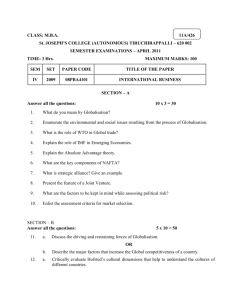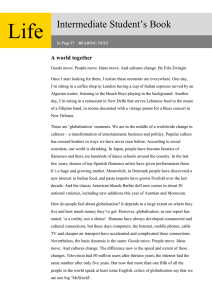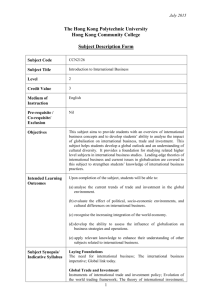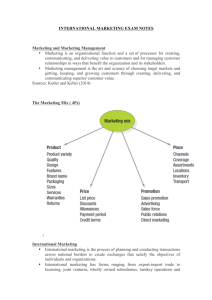Current Research Journal of Social Sciences 6(2): 48-54, 2014
advertisement
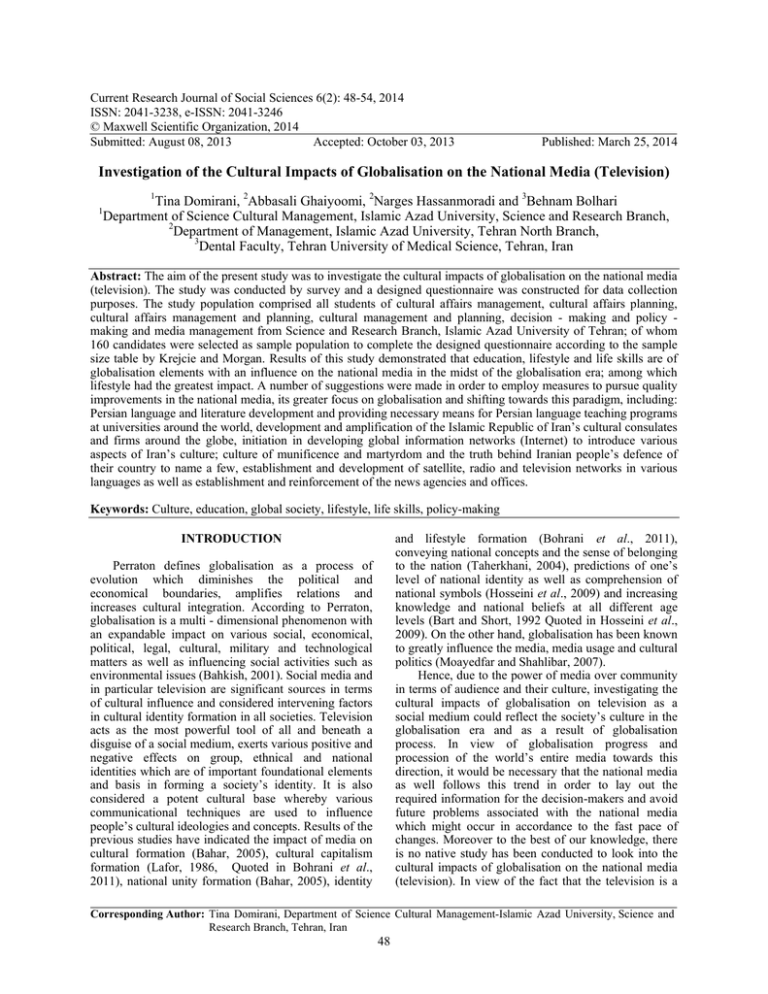
Current Research Journal of Social Sciences 6(2): 48-54, 2014 ISSN: 2041-3238, e-ISSN: 2041-3246 © Maxwell Scientific Organization, 2014 Submitted: August 08, 2013 Accepted: October 03, 2013 Published: March 25, 2014 Investigation of the Cultural Impacts of Globalisation on the National Media (Television) 1 Tina Domirani, 2Abbasali Ghaiyoomi, 2Narges Hassanmoradi and 3Behnam Bolhari Department of Science Cultural Management, Islamic Azad University, Science and Research Branch, 2 Department of Management, Islamic Azad University, Tehran North Branch, 3 Dental Faculty, Tehran University of Medical Science, Tehran, Iran 1 Abstract: The aim of the present study was to investigate the cultural impacts of globalisation on the national media (television). The study was conducted by survey and a designed questionnaire was constructed for data collection purposes. The study population comprised all students of cultural affairs management, cultural affairs planning, cultural affairs management and planning, cultural management and planning, decision - making and policy making and media management from Science and Research Branch, Islamic Azad University of Tehran; of whom 160 candidates were selected as sample population to complete the designed questionnaire according to the sample size table by Krejcie and Morgan. Results of this study demonstrated that education, lifestyle and life skills are of globalisation elements with an influence on the national media in the midst of the globalisation era; among which lifestyle had the greatest impact. A number of suggestions were made in order to employ measures to pursue quality improvements in the national media, its greater focus on globalisation and shifting towards this paradigm, including: Persian language and literature development and providing necessary means for Persian language teaching programs at universities around the world, development and amplification of the Islamic Republic of Iran’s cultural consulates and firms around the globe, initiation in developing global information networks (Internet) to introduce various aspects of Iran’s culture; culture of munificence and martyrdom and the truth behind Iranian people’s defence of their country to name a few, establishment and development of satellite, radio and television networks in various languages as well as establishment and reinforcement of the news agencies and offices. Keywords: Culture, education, global society, lifestyle, life skills, policy-making and lifestyle formation (Bohrani et al., 2011), conveying national concepts and the sense of belonging to the nation (Taherkhani, 2004), predictions of one’s level of national identity as well as comprehension of national symbols (Hosseini et al., 2009) and increasing knowledge and national beliefs at all different age levels (Bart and Short, 1992 Quoted in Hosseini et al., 2009). On the other hand, globalisation has been known to greatly influence the media, media usage and cultural politics (Moayedfar and Shahlibar, 2007). Hence, due to the power of media over community in terms of audience and their culture, investigating the cultural impacts of globalisation on television as a social medium could reflect the society’s culture in the globalisation era and as a result of globalisation process. In view of globalisation progress and procession of the world’s entire media towards this direction, it would be necessary that the national media as well follows this trend in order to lay out the required information for the decision-makers and avoid future problems associated with the national media which might occur in accordance to the fast pace of changes. Moreover to the best of our knowledge, there is no native study has been conducted to look into the cultural impacts of globalisation on the national media (television). In view of the fact that the television is a INTRODUCTION Perraton defines globalisation as a process of evolution which diminishes the political and economical boundaries, amplifies relations and increases cultural integration. According to Perraton, globalisation is a multi - dimensional phenomenon with an expandable impact on various social, economical, political, legal, cultural, military and technological matters as well as influencing social activities such as environmental issues (Bahkish, 2001). Social media and in particular television are significant sources in terms of cultural influence and considered intervening factors in cultural identity formation in all societies. Television acts as the most powerful tool of all and beneath a disguise of a social medium, exerts various positive and negative effects on group, ethnical and national identities which are of important foundational elements and basis in forming a society’s identity. It is also considered a potent cultural base whereby various communicational techniques are used to influence people’s cultural ideologies and concepts. Results of the previous studies have indicated the impact of media on cultural formation (Bahar, 2005), cultural capitalism formation (Lafor, 1986, Quoted in Bohrani et al., 2011), national unity formation (Bahar, 2005), identity Corresponding Author: Tina Domirani, Department of Science Cultural Management-Islamic Azad University, Science and Research Branch, Tehran, Iran 48 Curr. Res. J. Soc. Sci., 6(2): 48-54, 2014 pervasive medium, undertaking such study in a country like Iran which is in the midst of transition from tradition to modernity, is essential in assisting politicians and administrators in conservation of the cultural, national, religious, etc. values. The present study aims to investigate the cultural impacts of globalisation on television as the national medium from the perspective of media management and cultural management students from Science and Research Branch, Azad University of Tehran. Undoubtedly, the reflection of the cultural impacts of globalisation on the national media would be outlined in the society as well as the nation’s culture. THEORETICAL AND EMPIRICAL LITERATURE varies. It has furthermore indicated that social media has a great role in establishing values and social transformations in the developing countries. The results of a research conducted by Sarookhani and Karroubi (2009) has demonstrated that Iranian national television is promoting global patterns in most cases. However in case of the cultural terms, it is generally acting traditional. Therefore, the objective of the present study was to investigate the cultural impacts of globalisation on the national media (television). In this study, education in the global society (Rahimi and Nabiloo, 2008), life skills (Al-Allak et al., 2011), lifestyle (Wang et al., 2012) and religious cults (Hakiu Khundeker, 2004, Quoted in Monadi, 2007) are the structural elements forming the cultural outcomes of globalisation (Fig. 1). Theoretical literature: This research has been using the theories of cultural integration, world hierarchy and culture for elaboration of its concepts. According to the theory of world hierarchy and culture and from Walterstein’s viewpoint, even though the culture is not the sole base of every global transformation, it is a very powerful element which can define social and political relations and is able to transform them into social rules and traditions (Amirentekhabi and Heirannia, 2011). According to the theory of cultural integration and from the perspective of majority of theoreticians of the integration theory, cultural relations like the media, are the most important functions which can result in local and global integrations. The development of relations and cultural connections can further help to develop cultural interactions in societies. Ameli (2010) suggested that the concept of globalisation or modern ideological globalisation is a result of the “global relations industry” and is the base of internationalisation of cultures and civilizations. According to Shamsher and Nayeem Abdullah (2012), several years of research on the impact of social media on people have shown hat influences of media Empirical literature: A lot of researchers have a general pessimistic opinion on the impact of globalisation on culture and believe that globalisation through the loss of cultural identity and conquering those strong cultures which are in the midst of blooming, would result in struggles and producing stereotypes of the Western capitalism. Having said that, some other critics believe that globalisation causes distinction among cultures and that globalisation phenomenon would bring about an imprudent impact on local and tribal cultures (Amirentekhabi and Heirannia, 2011). The research of Shamsher and Nayeem Abdullah (2012) indicated that using media like satellite television in Bangladesh ha resulted in loss of social values and traditions among the people of that country. Hafeznia et al. (2000) has found that the development in globalisation processes in terms of amplifications in technological and communicational technologies (like satellite television and Internet) have reinforced the sense of national identity among the university students. To study the impact of globalisation on culture, we have to investigate cultural communication. Researchers who are pro-globalization Fig. 1: Research conceptual model 49 Curr. Res. J. Soc. Sci., 6(2): 48-54, 2014 believe that the pace, level, strength and volume of global cultural communications in our era has been uniquely exceeded all historical records. For instance, it could be perceived from the results of the research conducted by Nilson (2002, quoted in Monadi, 2007) that with the help of globalisation and through modern media and technologies such as Internet and satellite television, people have been exposed to the values from other cultures and since the media broadcasts public cultural values and as a results of these ever changing cultural values, there is indeed a cultural impact of globalisation on the national media in the midst of the globalisation era. Perhaps the reason behind the not so significant impact of the religious cult on the national media in our country as was found in the present study, would be that we are a traditional Islamic society and due to various national incidents such as the Islamic revolution followed by the imposed eight year-long war and promoted culture of Jihad and martyrdom, these cultural values have been manifested deeply within people and that the nation value them preciously. Cults such as generosity, self-sacrifice and the religion of our society are valued by the people and can be clearly seen in our national media and maybe that is the reason that globalisation had no influence on the national media and people are particular about the revolutions and the war values. The connection between the national media and the audience is like a two-way communication. So that the values of the viewers can be reflected by the national media and in return, the national media has an impact on the lifestyle and values of the nation and in particular the younger generation. Kuipers (2011) defined globalisation as an international cultural instrument. The result of his research in Italy, France, Netherlands and Poland showed that in these countries, television acted internationally. It is crucial to state that today cultural globalisation has an impact on individuals’ lives. In a research titled “The cultural impact of globalisation on youth with higher social status in Dhaka Singapore”, Zahid (2007) suggested that cultural changes in developing societies by the means of the modern media and technologies are inevitable. Today, the younger generation prefers fast food over traditional meals. Youth select modern clothing and fashion and prefer Western music and movies than others. They are closer to their classmates and college mates than their family members and are more comfortable to discuss about sexual matters and fashion with them rather than their families. The results of a research by Bohrani et al. (2011) has shown that media has a greater influence on people’s identity and lifestyles and this impact is more significant in girls rather than in boys. Although the national media influence could also be seen in boys. Results of research showed that the national media (television) affects the learning skills of its viewers (Singh and Gaurav, 2012). Having said that in the age of globalisation, using modern communication technologies such as Internet also shapes and promotes cultural values. In addition, a research of Wang et al. (2012), indicated that using the Internet changes the lifestyles of teenagers. Moreover, the research by Ravi (2012) showed that modern technologies altered the lifestyle of people, their thoughts and actions, their clothing and the structure of family hierarchy in India. On the basis of the literature reviewed, the following hypotheses posed: Ho1: To some extent education in the global society-as one of the cultural elements of globalisation- influences the national media. Ho2: To some extent life style-as one of the cultural elements of globalisation- influences the national media in the globalisation era. Ho3: To some extent life skills-as one of the cultural elements of globalisation-influence the national media in the globalisation era. Ho4: To some extent the religious cult-as one of the cultural elements of globalisation- influences the national media in the globalisation era. MATERIALS AND METHODS Research design: In the present study, the descriptive measurement approach was adopted. Sample: The statistical population included all students of cultural affairs management, cultural affairs planning, cultural affairs management and planning, cultural management and planning, decision-making and policy-making and media management from Science and Research Branch, Islamic Azad University of Tehran who were undertaking either Master’s or PhD programmes during 2012-2013 academic year. According to the data obtained from the university’s academic unit, a total of 250 eligible students were included in the statistical population. The required sample size based upon the sample size table by Morgan was calculated as 148 subjects and after considering the dropout rate, the final sample size comprising of 160 subjects were randomly chosen for enrolment in this survey. Instrument: In the present study, the needed data and information were acquired by a designed questionnaire. The prepared questionnaire contains 34 compiled questions in order to evaluate the impacts of globalisation on the national media (television). Education in the global society were assessed by nine questions followed by assessment of life skills, lifestyle, religious cults and social demographic variables which were done by five, eight, four and eight questions, respectively. Visual and content-addressed 50 Curr. Res. J. Soc. Sci., 6(2): 48-54, 2014 admissibility were used for demonstrative assessment of the questionnaire’s admissibility. After completion of the questionnaire designing task, each question was analysed by lecturers to study the suitability of multiple choice items for the assessed variable. Subsequently, unfitted and ambiguous items were either omitted or adjusted accordingly. After making the necessary amendments, the final questionnaire consisted of 34 items. stated that they were of Kurdish minority. Majority of the respondents (82.5%) were employed whereas as mere 15.6% were unemployed. 76% of the respondents reported that their fathers held a Bachelor’s degree, 20.6% of the respondents’ fathers held a college degree while 3% of the fathers were diploma holders. Meanwhile, more than half of the respondents’ mothers (52%) held a Bachelor’s degree, 20% held a college degree, 26% held a diploma degree while only less than 2% of respondents stated that their mothers had elementary school level education. Only a mere percentage of the respondents (2.5%) regarded the impact of the brain drain phenomena on reinforcement of the national media’s educational programmes as “high”, whereas 90.6% regarded this impact as “average” and 7% considered it to have “low” and “very low” impact. Moreover, 89% of the respondents considered the impact of pervading creativity towards globalisation “high” or “very high” in respect to the reinforcement of the national media’s educational programmes. When respondents were asked how they would rank the impact of the global skilled intellectual and professional personnel’s knowledge on reinforcement of the national media’s educational programmes, 88% considered this impact “average” while the remaining 9% considered it “low” and “very low”. Meanwhile, majority of the respondents gave the impact of global education on reinforcement of the national media’s educational programmes, a rating of “high”. Similarly, the impact of uniformity in education and global standards on reinforcement of the national media’s educational programmes was regarded as “high” by 87% of the respondents. 89% of the respondents reported that they believed the spread of the English language could exert “high” impact on reinforcement of the national media’s educational programmes. With respect to the impact of virtual education in the global village on impact on reinforcement of the national media’s educational programmes, solely a mere 5.6% considered it “high”. 15.6% believed it to have an “average” impact while majority of the respondents (79%) considered the impact to be “low”. On the contrary, 87.5% of the respondents stated that the impact of the widespread utilisation of the new technologies on reinforcement of the national media’s educational programmes was either “high” or “very high”. Furthermore according to the vast majority of the respondents (89%), the impact of an increase in the number of the academic degrees and intellectual rankings conferred by the overseas universities and educational institutes on reinforcement of the national media’s educational programmes was considered “high”. From the viewpoint of 25.6% of the respondents, generation of self-awareness skills on the basis of ultra-nationalistic facts had “high” impact on the national media’s educational programmes, while 56% considered it “average” and 18% considered it Data analysis technique: In order to calculate the final coefficient, a random sample consisting of 30 students from Science and Research Brach, Azad University of Tehran were selected to complete the initial questionnaire. The final assessment regarding the repeated measurements of the questionnaire’s multiple choice items were conducted using Cronbach’s α (alpha). The final coefficient α for the education in the global society item was 0.789, for life skills item was 0.802, for lifestyle item was 0.821 and in terms of religious cult was 0.756 which indicated that the survey items most likely contributed to a reliable scale and desired internal consistency of the designed questionnaire. The questionnaire included four dimensions (education in the global society, life skills, lifestyle and religious cult). All the five point choice answers were coded on a scale of 1 to 5 and each question was assigned a score between 1 and 5. The statistical analysis of data was conducted by SPSS software on two levels of descriptive and inferential analyses. Descriptive analysis of data was done using frequency distribution tables and percentile ranks whereas inferential analysis was carried out through one-sample median test, Pearson correlation and ChiSquare test for examining the hypothesis while taking the level of variable evaluation into the account. RESULTS AND DISCUSSION This survey aimed at studying the cultural impacts of globalisation on television as the national media from the perspective of media management and cultural management students from Science and Research Branch, Islamic Azad University of Tehran. In this research, the study population consisted of 160 students undertaking media and cultural management programmes whom responded to the survey; from which 51 (31.9%) respondents were male and 109 (68.1%) were female. 88% of the respondents were undertaking Master’s degree while the remaining 12% were PhD holders. 15.6% of respondents aged between 18-25, 52.5% of respondents aged between 26-33 and 32% were above 33 years of age. More than half of the respondents (56%) were married and 44% were single. In terms of race and ethnicity, the majority of the respondents (70%) self identified as Persian, 24% as Azeri, 4% as Lor and less than 1% of the respondents 51 Curr. Res. J. Soc. Sci., 6(2): 48-54, 2014 Table 1: One-sample median test N Education 160 Life skills 160 Lifestyle 160 Religious cult 160 Lower median 2 14 0 3 Equal median 20 105 18 175 “low” and very low”. When asked about the impact of empathetic manners and skills in the virtual space on the national media’s educational programmes, 89% of the respondents ranked it “high” or “very high”. The survey report also indicated that only 5.6% of the respondents believed in “high” impact of communicational skills in the global space on the educational programmes of the national media, whereas majority (87%) considered it “average” and 7.5% of the respondents considered it “low” and “very low”. Meanwhile, 92% of the respondents agreed that the impact of inter-personal skills at the international level on the national media’s educational programmed was “high” and “very high”. On the other hand, 84% of respondents said they regarded the impact of enthusiasm management based on the Western theories on the television’s educational programmes as “medium” while 16% considered it “low” and “very low”. Less than 10% of the respondents (9.4%) stated that the impact of the global lifestyle on the national media’s educational programmes was “high” and “very high” while the majority (89%) said the impact was just “average”. The survey report also demonstrated that according to the perspective of 90.6% of the respondents, growing tendencies toward fashion in terms of clothing and outfit had either “high” and “very high” impact on the national media’s educational programmes. Virtually all of the respondents (99%) agreed on “very high” and “high” impact of growing interest toward possession of expensive and luxurious cars on the national media’s educational programmes. Similarly, a vast majority of respondents reported “high” and “very high” impact of the increasing trend toward consumption of fast food instead of the traditional foods on the national media’s educational programmes. The survey report indicated that just a mere 1% of respondents regarded the impact of growing interest towards Western music as an alternative to the Iranian classical music on the national media’s educational programmes as “high”, while majority of 86% considered it “average” and 12.5% considered it “low”. 88% of respondents reported “high” and “very high” impact of drifting towards filling the spare time by watching satellite channels, browsing internet and other ultra-nationalistic means of social communication on the media’s educational programmes. Meanwhile, only 9% of the respondents indicated “high” and “very high” impact of the spread of consumerism culture based on the Western culture on the national media’s educational programmes, while 79% considered it “average” and 12% evaluated it “low” and “very low”. Majority of the respondents Upper median 138 41 142 0 p-value 0.0000 0.0002 0.0000 1.0000 Median 4 3 4 3 (89%) reported “high” and “very high” impact of the spread of luxurism cult based on the Western culture on the national media’s educational programmes and comparably, a solid majority (96%) of respondents reported “high” impact of conceptualisation of the religious matters by the global media in determining the nature of the religious programmes airing on the national media. Furthermore, 14% of respondents believed “high” impact of the Islamic culture perception in the international media on the national media’s educational programmed while 84% considered it to have an “average” impact. Additionally, 10.6% of respondents said that they thought the impact of concurrency between the international media’s programmes and the national media’s programmes in terms of religion was “average”, while 89% reported “low” and “very low”. When asked about the impact of appreciation of the ultra – nationalistic religious conceptions at the international level, 5.6% considered it “average”, while majority of the respondents (94%) considered it “low” and “very low”. Overall, 86% of respondents believed in “high” impact of education in the global society on the national media; whereas 25% of them reported “high” impact of life skills on the national media when 65.6% considered it “average”. A vast majority of the respondents regarded the impact of lifestyle on the national media as “high”, while virtually the entire respondents (98%) agreed on the “average” impact of religious cult on the national media. Due to the fact that the studies variables in the present survey were not normally distributed, the one-sample median test was employed in order to study the impact of each one of these variable on the national media (Table 1). As illustrated in the above table, the calculated pvalue regarding the three variables of education, life skills and lifestyle had values less than 0.05. Therefore, the null hypothesis was rejected at p<0.05 and this is an indication of the significant effect of education, life skills and lifestyle on the national media’s programmes. Moreover, since the p-value for the religious cult variable was greater than 0.05, it was concluded that this variable did not have a significant impact on the national media. CONCLUSION The results of this research indicated that from the student’s perspective, life skills and lifestyles have an impact on the national media in the global society. The results showed that religious cult had no significant influence on the national media in this globalisation era. 52 Curr. Res. J. Soc. Sci., 6(2): 48-54, 2014 We can point to education as a mean for the globalisation of the national media and it is important to emphasise that along with the change in concepts, cultures and human beliefs, the goal of education also changes. Furthermore, globalisation influences societies on different levels and changes their religious, culture and political viewpoint which might as well get influenced by time and location or even beyond these scopes. Kakia (2007) Quoted in Amirentekhabi and Heirannia, 2011). Believes that in the age of globalisation, education is no longer a passive action and instead is built upon the multi - dimensional actions and reactions between the educator and the learner. Learners have started to play a stronger role in this process and begun to influence the selection of the education topics. Furthermore, complex sensual skills like critical thinking, questioning and questing tasks have been developed through interaction of the thoughts and actions. All aspects of human being’s existence are being paid attention to by the educators and emotional, critical, physical and moral dimensions are being magnified in order to answer the needs of the individuals as well as the entire society. Kakia (2007) Quoted in Amirentekhabi and Heirannia, 2011), believes that in the globalisation era, the connection between people and education is getting more significant. Al-Allak et al. (2011) have conducted a research on the transformation of education in the globalisation era and found that higher learning institutions should change accordingly thorough the time and employ modern educational technologies instead of traditional learning techniques. They pointed out that higher learning institution around the world should use helpful strategies to increase their potential in confronting challenges arising due to the globalisation phenomena. To reach this aim, higher learning institutions and universities should make sure that their educational programs and techniques are updated correspondingly. Today, the higher learning institutions must employ novel educational technologies in additional to the critical thinking and problem-solving skills to make their students ready to acquire global knowledge. Public media is a mean for transferring values and reaching public support for integration and application of social dos and don’ts. In view of this matter, the present study found that in the age of globalisation, globalisation’s cultural influences had significant impacts on the national media and the occurrence of changes in education in this era, life skills and lifestyles and their impact on the national media programmes were clearly illustrated. Generally, the media could be perceived as a mean to interpret the public’s understanding of the social do’s and don’ts and people’s perception of their social and physical surroundings. Moreover it is also a mean to demonstrate the perspective of the society of their moral, emotional, ethical and spiritual values and a manifestation of public standards for each social role (like gender, age and employment) (Boren, 2000, quoted in Monadi 2007). The mentioned concept of the national media arises generally due to its important role in attracting large number of audience and its great impact on perceptions. In fact television is a powerful mean for attracting vast number of audience with no boundaries in respect to age, gender, income and educational level. In addition to that, television employs both sound and visual pictures and as a result has the ability to draw a close-to-reality picture of products and people (Shamsher and Nayeem Abdullah, 2012). REFERENCES Al-Allak, B.A., A. Salih Alnaser and M. Abdulellah Saeed, 2011. Education and globalization: Conceptual and visionary approach. J. Adv. Social. Res., 1(1): 1-10. Ameli, S.R., 2010. Belonging to two worlds and relations between civilizations: Analyzes of cultural relations in the world. Sci. Res. J. Cult. Res., 3(1): 1-37. Amirentekhabi, S. and J. Heirannia, 2011. Media application in identity. Soc. Sci. Bull., 84: 109-122. Bahar, M., 2005. Television agent of change or agent of cultural damage. J. Iran. Assoc. Cultural Stud. Commun., 1(2,3): 195-206. Bahkish, M.M., 2001. Iran in the Course of Globalization. Nay Publication, pp: 24. Bohrani, Sh., S. Maryam and M. Hosseini, 2011. Gender comparison in the media, identity and lifestyle among Shiraz youth. Res. J. Nat. Stud., 12(47): 103-120. Hafeznia, M.R., M. Kavian Rad, Y. Karimi Poor and M. Taherkhani, 2000. The Impact of globalization on national identity (Case study: Students of Tehran public universities). Geo-politic J., 2(34): 1-21. Hosseini, A., M. Darvizeh, Z. Khosravi and Z. Poorshahriari, 2009. The role of the media in the development of national identity of the teenagers of Tehran. J. Relat. Stud., 16(2): 39-64. Kuipers, G., 2011. Cultural globalization as the emergence of a transnational cultural field: Transnational television and national media landscapes in four European countries. Am. Behav. Sci., 55(5): 541-557. Moayedfar, S. and A.V. Shahlibar, 2007. Globalization and local cultural policy formation: Iranian Baloch media consumption and the challenges of ethnic identity and national identity. Faculty Lit. Hum., 15(56-57): 183-208. Monadi, M., 2007. Leisure and challenges of globalization, comparison of two generations. Cult. Stud. Commun., 3(8): 131-165. 53 Curr. Res. J. Soc. Sci., 6(2): 48-54, 2014 Singh, A. and A. Gaurav, 2012. Television exposure and academic skills of children: New findings from India. J. Commun. Technol. Hum. Behav., 1: 1-24. Taherkhani, M., 2004. The impact of globalisation on women. Women Res., 1: 93-111. Wang, L., J. Luo, W. Gao and J. Kong, 2012. The effect of Internet use on adolescents’ lifestyles: A national survey. Comput. Hum. Behav., 28(6): 2007- 2013. Zahid, D., 2007. Impact of cultural globalization on the upper class youth in Dhaka city: A sample study. Bangladesh E. J. Sociol., 4(2): 1-11. Rahimi, M. and Z. Nabiloo, 2008. Globalization and the need of improvement of English language courses in Iran, challenges and opportunities. J. Edu. Tech., 3(2): 115-124. Ravi, B.K., 2012. New Media, Culture and Society. Retrieved form: http://www.savap.org. pk/journals/ ARInt./ Sarookhani, B. and Z. Karroubi, 2009. The process of globalization and its impact on the role of the media in the culture of Iran. Sci. Res. Mag. Soc. Sci., 47: 37-73. Shamsher, R. and M. Nayeem Abdullah, 2012. Effect of satellite television on the culture of Bangladesh: The viewers perception. Eur. J. Bus. Manage., 4(9): 45-56. 6T 54 6T
